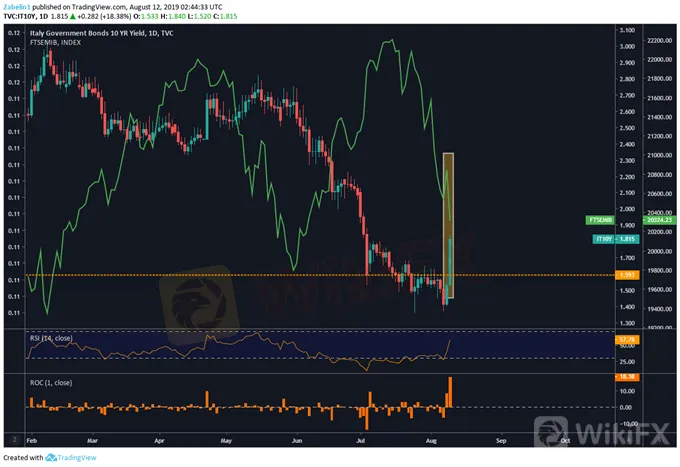简体中文
繁體中文
English
Pусский
日本語
ภาษาไทย
Tiếng Việt
Bahasa Indonesia
Español
हिन्दी
Filippiiniläinen
Français
Deutsch
Português
Türkçe
한국어
العربية
US Dollar May Rise Against Euro as Italian Political Risk Mounts
Abstract:The US Dollar and Swiss Franc may rise against the Euro as Italian politics may temporarily steal the spotlight as the biggest political risk in Europe next to Brexit.
EURO, SWISS FRANC, US DOLLAR, ITALIAN POLITICS – TALKING POINTS
The US Dollar and Swiss Franc may gain on risk aversion from Italy political threat
Deputy PM Matteo Salvini may challenge Giuseppe Conte via vote of no confidence
Rome-Brussels budget dispute may resurface, pressuring Euro, Italy sovereign debt
Learn how to use political-risk analysis in your trading strategy!
EURUSD and EURCHF may fall if volatile Italian politics spook markets and compel traders to redirect capital into anti-risk assets like USD or CHF. Deputy Prime Minister Matteo Salvini of the Lega Nord party intends on challenging the current PM Giuseppe Conte through a vote of no confidence. If he succeeds, Salvini will have an opportunity to break away from the conflict-prone coalition government and consolidate power.
He will then be able to put forward his agenda with less internal friction obstructing him from fulfilling his campaign promises of tax cuts. He has already been acting as the unofficial head of the government, though a successful snap election might make it official. With Salvini as the de-facto vanguard of European fiscal exceptionalism, markets will brace for what could be another budget battle between Rome and Brussels.
But this time the market impact may be more severe because the economic outlook has drastically deteriorated over the past few months. Major central banks in both developing and developed economies have cut rates or significantly scaled back their prior rate hike plans. A political shock out of Italy could resurrect the fear of another Eurozone debt crises that could bring down the Euro and global financial markets with it.
Want to learn more about how politics impacts financial markets? Be sure to follow me on Twitter @ZabelinDimitri.
CHART OF THE DAY: ITALIAN BOND YIELDS SPIKE, ITALY FTSE MIB PLUMMETS

Disclaimer:
The views in this article only represent the author's personal views, and do not constitute investment advice on this platform. This platform does not guarantee the accuracy, completeness and timeliness of the information in the article, and will not be liable for any loss caused by the use of or reliance on the information in the article.
Read more

KVB Market Analysis | 28 August: Yen Strengthens on BoJ Rate Hike Hints; USD/JPY Faces Uncertainty
The Japanese Yen rose 0.7% against the US Dollar after BoJ Governor Kazuo Ueda hinted at potential rate hikes. This coincided with a recovery in Asian markets, aided by stronger Chinese stocks. With the July FOMC minutes already pointing to a September rate cut, the US Dollar might edge higher into the weekend.

KVB Market Analysis | 27 August: AUD/USD Holds Below Seven-Month High Amid Divergent Central Bank Policies
The Australian Dollar (AUD) traded sideways against the US Dollar (USD) on Tuesday, staying just below the seven-month high of 0.6798 reached on Monday. The downside for the AUD/USD pair is expected to be limited due to differing policy outlooks between the Reserve Bank of Australia (RBA) and the US Federal Reserve. The RBA Minutes indicated that a rate cut is unlikely soon, and Governor Michele Bullock affirmed the central bank's readiness to raise rates again if necessary to combat inflation.

KVB Market Analysis | 23 August: JPY Gains Ground Against USD as BoJ Signals Possible Rate Hike
JPY strengthened against the USD, pushing USD/JPY near 145.00, driven by strong inflation data and BoJ rate hike expectations. Japan's strong Q2 GDP growth added support. However, USD gains may be limited by expectations of a Fed rate cut in September.

KVB Market Analysis | 22 August: Gold Stays Strong Above $2,500 as Fed Rate Cut Hints Loom
Gold prices remain above $2,500, near record highs, as investors await the Federal Open Market Committee minutes for confirmation of a potential Fed rate cut in September. The Fed's dovish shift, prioritizing employment over inflation, has weakened the US Dollar, boosting gold. A recent revision showing the US created 818,000 fewer jobs than initially reported also strengthens the case for a rate cut.
WikiFX Broker
Latest News
The Withdrawal Trap: How Scam Brokers Lure Victims into Paying More
FCA to Investors: Think Twice Before Trusting These Brokers
Trump\s tariffs: How could they affect the UK and your money
Trump gambles it all on global tariffs he\s wanted for decades
TradingView Brings Live Market Charts to Telegram Users with New Mini App
Trump tariffs: How will India navigate a world on the brink of a trade war?
Interactive Brokers Launches Forecast Contracts in Canada for Market Predictions
Authorities Alert: MAS Impersonation Scam Hits Singapore
IG Group Acquires Freetrade for £160M to Expand UK Investment Market
U.S. March ISM Manufacturing PMI Released
Currency Calculator







